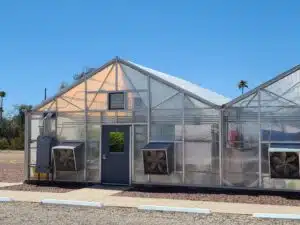
Agrivoltaics: Making the Most of Sunlight for Electricity and Agriculture

Agrivoltaics, blending agricultural and solar energy production on the same land, is innovative in promoting sustainable farming practices. It utilizes solar panels positioned above crops, enhancing land use efficiency, diminishing water needs, and creating new income avenues for farmers. Highlighted benefits of agri voltaics, supported by research, include significant reductions in water use by crops under solar panels and boosts in productivity and land efficiency. These agrivoltaic farming advantages align with sustainable farming goals, offering insights into how combining agriculture with renewable energy can foster environmental and economic benefits.
For more detailed insights, consider exploring comprehensive reviews and studies in MDPI journals and other reputable sources that discuss the efficacy and benefits of agri voltaics in modern agriculture.
The advantages of agrivoltaics have been demonstrated in several research studies. For example, a study conducted by researchers at Oregon State University found that shading provided by solar panels can reduce water requirements for crops by up to 60 percent while increasing their productivity by up to 30 percent. Another study published in the journal Nature Sustainability found that agrivoltaic systems can lead to a 60 percent increase in land productivity and up to 40 percent reduction in water use.
Learn more about Agrivoltaics with a comprehensive review from MDPI journals.
A 2022 paper by Camporese and Abou Najm published in Earth’s Future highlights the need for revolutionary solutions for the water, energy, and food nexus. The authors propose light as a resource that can be allocated based on need, allowing for dual or multiple uses in the same location. This can lead to the advancement of several agricultural innovations, including agrivoltaics and hydroponics.
The authors discuss how advancing knowledge in plant response to different light spectra is necessary to design systems capable of achieving sustainable land management with optimum crop productivity and water use. This paper discusses the potential of agrivoltaics to improve land and water efficiencies and reduce heat stress on plants. The study highlights the use of wavelength-selective semi-transparent solar panels, which harvest some parts of the incoming light spectrum to generate energy, while allowing the parts of the spectrum that are useful for the plants to pass through.
The study suggests that the blue part of the spectrum is the most promising for energy production. The model presented in the study can be used to assess the suitability of different plant species for use in agrivoltaics, but more studies are needed to update and re-interpret the information. The study also highlights the importance of using an innovative stomatal conductance formula to model the photosynthesis and transpiration rates of plants in response to changing light spectra. Finally, the study concludes that there are a number of challenges that need to be addressed to confirm whether the preliminary conclusions can be applied in real-world agrivoltaic applications.
Economic Advantages
In terms of economic advantages, a study published in the journal Renewable and Sustainable Energy Reviews found that agrivoltaic systems can provide farmers with a significant source of additional income. The study, which analyzed several case studies from around the world, found that agrivoltaic systems can increase the annual income of farmers by up to 60 percent.
One notable example of a successful agrivoltaics project is the Solar Crop project in Japan. This project involves the installation of solar panels above rice paddies, which has resulted in increased rice yields and reduced water requirements. The project has been so successful that it has been expanded to other parts of Japan.

Another example is the Montpellier Agrivoltaic Solar Experiment (MAES) in France. This project involves the installation of solar panels above grapevines, which has led to improved grape quality and reduced water requirements. The project has also demonstrated economic benefits for farmers, with the solar panels providing additional revenue through the sale of electricity.
Figure 2. Experimental agrivoltaic system in Montepellier, France
Luminescent solar concentrators for use in agrivoltaics
Figure 3. Luminescent Solar Concentrators made at UbiQD, Inc.
Luminescent solar concentrators (LSCs) are devices that can absorb sunlight over a large area and then concentrate and direct the light to a small area where it can be converted into electricity. In agrivoltaics, LSCs can be used to capture sunlight and convert it into electricity while also providing shading for crops.
LSCs could be integrated into greenhouses or other structures used in agricultural settings to provide both electricity and shade for crops. The LSCs could be placed on the roof or walls of the structure, and the light they capture could be directed to solar cells that generate electricity. The shading provided by the LSCs could help regulate the temperature and light intensity inside the structure, which could benefit the growth and productivity of the crops.
Furthermore, LSCs could be used in combination with other solar technologies to optimize the use of available land. For instance, LSCs could be installed on the sides or tops of PV solar panels to capture and convert the light that is not absorbed by the PV cells, which would increase the efficiency of the system and provide additional energy for the crops.
Conclusion
In conclusion, agrivoltaics, an innovative approach combining agriculture and photovoltaics, offers multiple benefits such as increased land productivity, reduced water usage, and additional revenue for farmers. Highlighting successful global projects and future advancements like Luminescent Solar Concentrators (LSCs), it underscores the potential for ag voltaics to enhance sustainable farming practices. Addressing challenges like plant response to light spectra is crucial. With its significant benefits, agrivoltaics stands as a promising solution for sustainable agriculture, supporting the water, energy, and food nexus.

Dr. Damon Hebert
Dr. Damon Hebert serves as Director of Agriculture Research for UbiQD, Inc., with a background in solar materials and controlled environment cannabis cultivation. He is an advocate for the use of advanced materials to further the industry’s push towards sustainable farming practices. He can be reached at [email protected].
Share:
Related Posts
Social
Categories
Boubaker, K., Jomaah, J., Socolof, M., & Dupraz, C. (2020). Agrivoltaic systems: A review of status quo. Renewable and Sustainable Energy Reviews, 125, 109794.
Camporese, M. & Abou Najm, M. (2022). Not All Light Spectra Were Created Equal: Can We Harvest Light for Optimum Food-Energy Co-Generation? Earth’s Future, 10.
Elobeid, A., Zhang, Y., & Djaneye-Boundjou, G. (2021). Agrivoltaics for sustainable agriculture: A review. Journal of Cleaner Production, 317, 128360.
Heidari, N., Fotouhi, A., & Maleki, A. (2021). A review on agrivoltaic systems: Benefits and challenges. Renewable Energy, 173, 491-504.
St. Clair, S. B., & Lynch, J. P. (2010). The opening of Pandora’s Box: climate change impacts on soil fertility and crop nutrition in developing countries. Plant and Soil, 335(1-2), 101-115.
Connect With Us
Company
Resources


Hunter McDaniel, PhD
Founder & CEO
Hunter earned a Ph.D. in Materials Science and Engineering at the University of Illinois at Urbana-Champaign, before joining Los Alamos National Laboratory in the Chemistry Division. Ultimately the value proposition of UbiGro is about boosting crop yields and quality without the cost or energy impact of lighting. Hunter has more than fifty publications and patents, and more than 2000 total citations, h-index: 20. Hunter fundamentally believes that novel materials underpin every significant technology advancement, and he is focused on leveraging new materials to have a lasting and sustainable impact.

Damon Hebert, PhD
Director of Agriculture
Damon brings a wide range of experience in agriculture, materials science, spectroscopy, and small business. During his time in Prof. Angus Rockett’s research group at The University of Illinois at Urbana-Champaign (UIUC), Hebert authored a doctoral thesis and multiple papers on the materials science of CIGS semiconductor materials, which is closely related to the materials developed at UbiQD. He also served as a consultant to Nanosolar, a CIGS nanocrystal solar cell manufacturing company. Hebert has industry experience having co-founded Dr. Jolly’s, a leading cultivation and distribution operation in Bend, OR.

Tania Lafaille
Sales Representative
Tania is a UbiGro Sales Representative, with over 7 years of experience in product sales (specifically berries and avocados) covering all of North America and parts of South America. While in agriculture, Tania has cultivated strong relationships with growers and distributors, granting her a unique insight into both perspectives. That understanding, paired with her fierce dedication to results, drives her fun and fiery commitment to her craft. Tania is based in Gilroy, CA.

Tyler Veyna
Sales Representative
Tyler brings 15 years of experience in Greenhouse production and facility management of a wide range of crops in multiple states to the UbiGro team. Based in Salinas, California. “Being a fourth-generation farmer, I look to improve and empower the grower, and with UbiGro, we can do just that.”

Jim Gideon
Sales Manager
Jim Gideon is an UbiGro Sales Manager, with over 25 years of greenhouse industry sales experience covering all of North America. Previously Jim has worked for Green Tek, Plazit-Polygal, Texel, Cherry Creek, and Nexus. He is based in Montgomery, AL, and Jim believes that “light is everything to the grower.”

Eric Moody
Director of Sales
Eric Moody is UbiQD’s Director of UbiGro Sales. Eric has more than 6 years of experience in horticulture lighting industry, building relationships with greenhouse growers of all sizes and crops on optimal lighting for their growing operation, and most recently managed a North American sales team for PL Light Systems. Overall, Eric has been in sales leadership positions for more than 13 years. Eric brings with him a great understanding of the market and available technologies for growers, greenhouse facilities, and sales leadership. Reach Eric by phone at 541-490-6421 or by email at [email protected].

Mike Burrows, PhD
Dr. Michael Burrows is UbiQd’s Vice President of Business Development. His educational background includes a Materials Science doctorate from the University of Delaware and an MBA from Duke University Fuqua School of Business. His career has specialized in the commercialization of novel electronic materials in venture-run programs for different industries including solar, biosensors, and the automotive industry. In both start-up and corporate environments, he has extensive experience in global market development, foraging supply chain partnerships, productization, and brand building. He is currently leading UbiQD’s partnership efforts in luminescent greenhouse technology, smart windows, and security ventures.

Matt Bergern, PhD
Cheif Product Officer
As Chief Product Officer at UbiQD, Dr. Matt Bergren leads the company’s product development efforts, sales, and product manufacturing, including the company’s first commercial agriculture product, UbiGro. He plays a critical role in continuing the company’s path of technology development and vision of powering product innovations in agriculture, clean energy, and security.
He serves as the principal investigator for UbiQD’s contract with NASA, focused on tailoring the solar spectrum for enhanced crop production for space missions. Dr. Bergren’s leadership experience includes serving on the board of directors for the New Mexico Energy Manufacturing Institute, focused on job creation in New Mexico’s energy, and related manufacturing community.







